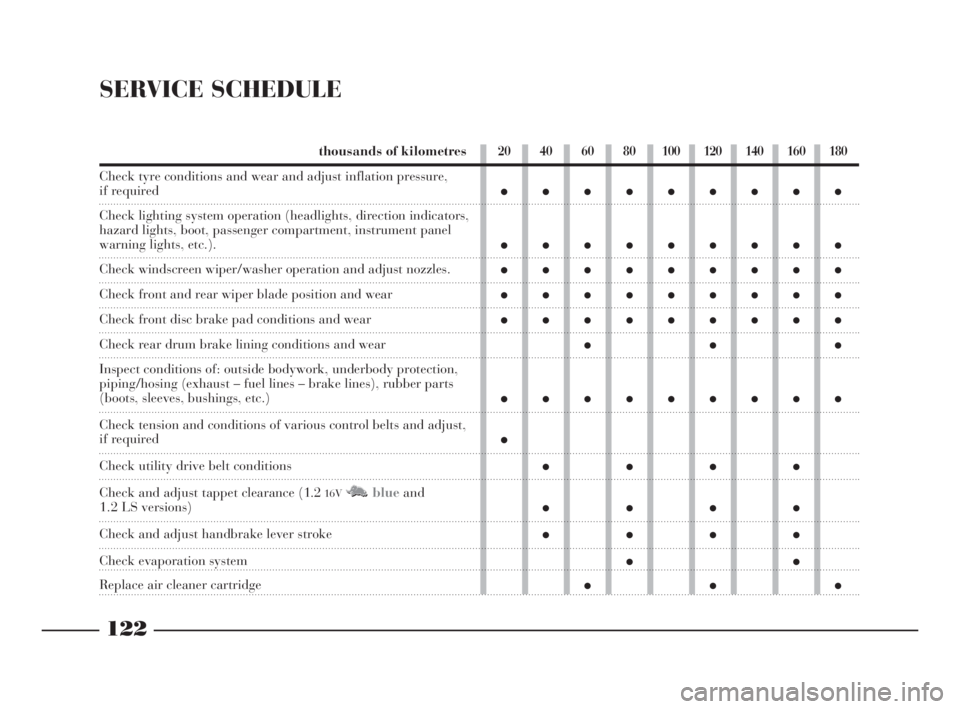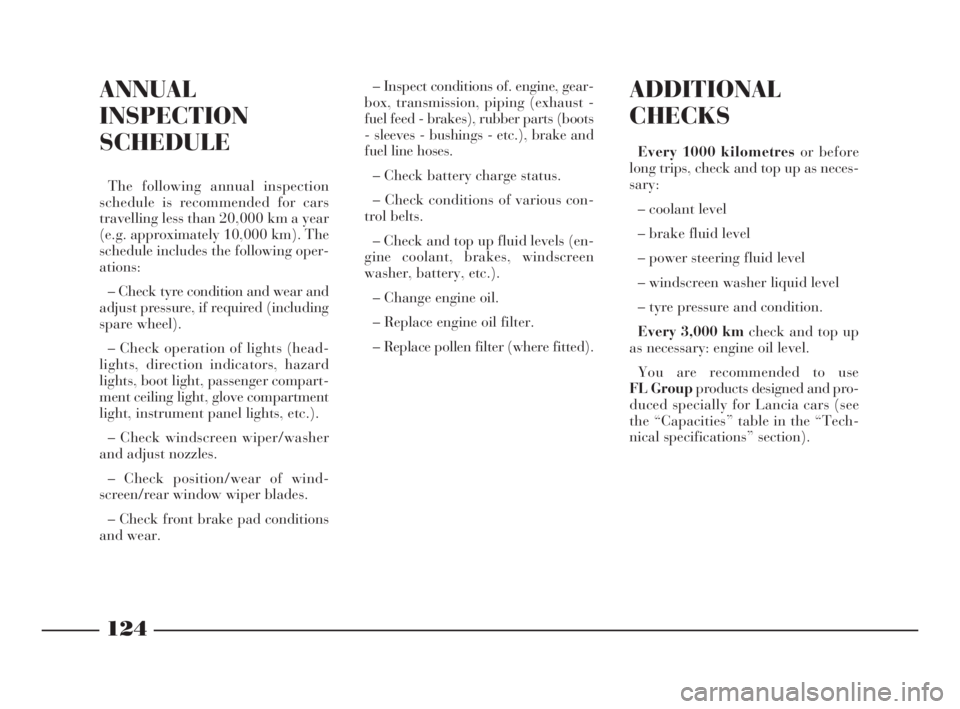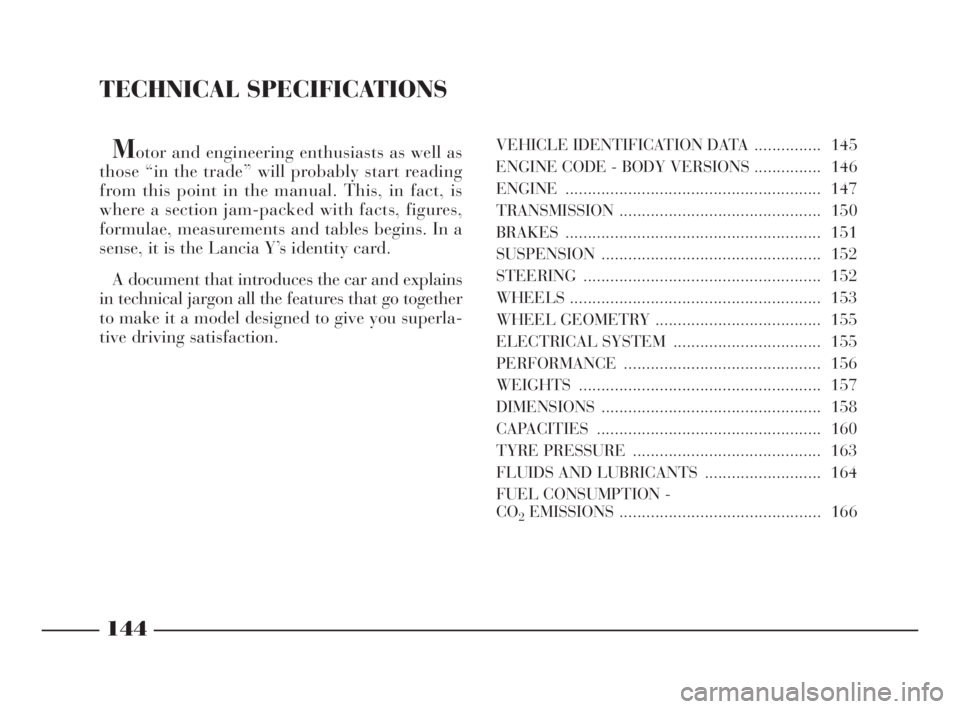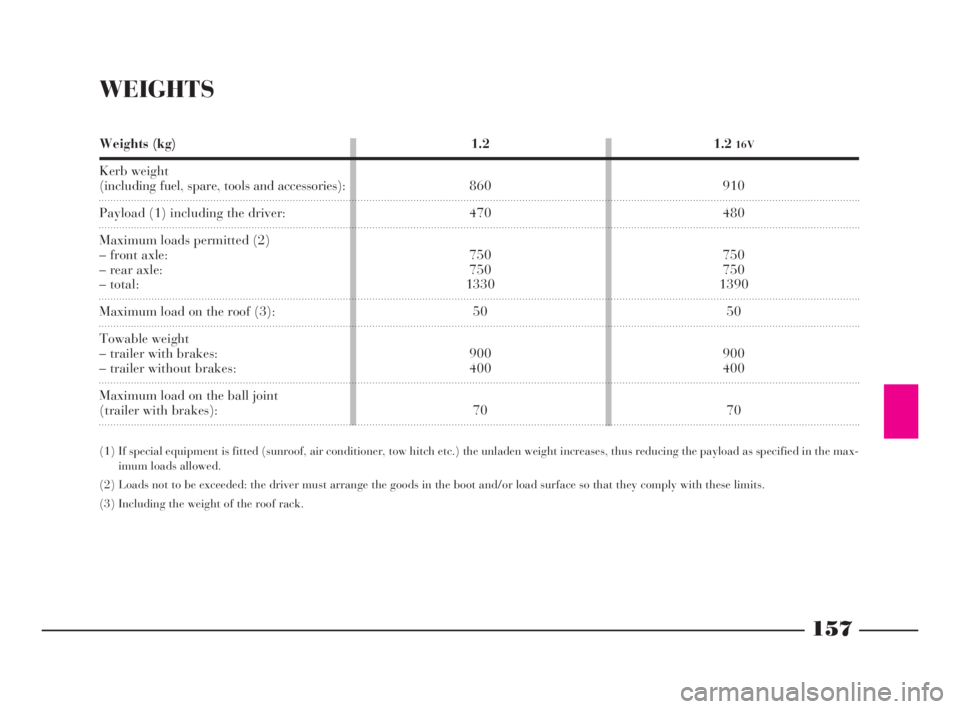fuel Lancia Ypsilon 2002 Owner handbook (in English)
[x] Cancel search | Manufacturer: LANCIA, Model Year: 2002, Model line: Ypsilon, Model: Lancia Ypsilon 2002Pages: 191, PDF Size: 2.45 MB
Page 125 of 191

122
G
SERVICE SCHEDULE
thousands of kilometres
Check tyre conditions and wear and adjust inflation pressure,
if required
Check lighting system operation (headlights, direction indicators,
hazard lights, boot, passenger compartment, instrument panel
warning lights, etc.).
Check windscreen wiper/washer operation and adjust nozzles.
Check front and rear wiper blade position and wear
Check front disc brake pad conditions and wear
Check rear drum brake lining conditions and wear
Inspect conditions of: outside bodywork, underbody protection,
piping/hosing (exhaust – fuel lines – brake lines), rubber parts
(boots, sleeves, bushings, etc.)
Check tension and conditions of various control belts and adjust,
if required
Check utility drive belt conditions
Check and adjust tappet clearance (1.2
16VM Nblueand1.2 LS versions)
Check and adjust handbrake lever stroke
Check evaporation system
Replace air cleaner cartridge
20 40 60 80 100 120 140 160 180
●●●●●●●●●
●●●●●●●●●
●●●●●●●●●
●●●●●●●●●
●●●●●●●●●
●●●
●●●●●●●●●
●
●●●●
●●●●
●●●●
●●
●●●
4C120-143 ING 11-03-2008 12:01 Pagina 122
Page 127 of 191

124
G
ADDITIONAL
CHECKS
Every 1000 kilometres or before
long trips, check and top up as neces-
sary:
– coolant level
– brake fluid level
– power steering fluid level
– windscreen washer liquid level
– tyre pressure and condition.
Every 3,000 kmcheck and top up
as necessary: engine oil level.
You are recommended to use
FL Groupproducts designed and pro-
duced specially for Lancia cars (see
the “Capacities” table in the “Tech-
nical specifications” section).
ANNUAL
INSPECTION
SCHEDULE
The following annual inspection
schedule is recommended for cars
travelling less than 20,000 km a year
(e.g. approximately 10,000 km). The
schedule includes the following oper-
ations:
– Check tyre condition and wear and
adjust pressure, if required (including
spare wheel).
– Check operation of lights (head-
lights, direction indicators, hazard
lights, boot light, passenger compart-
ment ceiling light, glove compartment
light, instrument panel lights, etc.).
– Check windscreen wiper/washer
and adjust nozzles.
– Check position/wear of wind-
screen/rear window wiper blades.
– Check front brake pad conditions
and wear.– Inspect conditions of. engine, gear-
box, transmission, piping (exhaust -
fuel feed - brakes), rubber parts (boots
- sleeves - bushings - etc.), brake and
fuel line hoses.
– Check battery charge status.
– Check conditions of various con-
trol belts.
– Check and top up fluid levels (en-
gine coolant, brakes, windscreen
washer, battery, etc.).
– Change engine oil.
– Replace engine oil filter.
– Replace pollen filter (where fitted).
4C120-143 ING 11-03-2008 12:01 Pagina 124
Page 140 of 191

137
G
If you get a flat tyre, stop immedi-
ately and change it so as not to dam-
age the tyre, the wheel, the suspension
and the steering.
Tyres age even if they are not used
very much. Cracking of the tread rub-
ber and the side walls are a sign of
this ageing. In any case, if the tyres
have been fitted for more than six
years they should be examined by an
expert who can judge whether they
are still fit for use. Remember to
check the spare tyre particularly care-
fully too.
If a replacement is necessary, always
use new tyres and avoid using ones
the origin of which you are not certain
about.
Lancia Y uses tubeless tyres. Under
no circumstances should an inner
tube be used with these tyres.
If you replace a tyre it is a good idea
to change the inflation valve, too.To ensure the front and rear tyres all
wear evenly, you are advised to
change the tyres over every 10-15
thousand kilometres keeping them on
the same side of the car so as not to
reverse the direction of rotation.RUBBER TUBING
Follow the Service Schedule care-
fully in the case of the braking and
fuel supply systems rubber hoses.
Ozone, high temperatures and long
absence of liquid in the system can in
fact cause the hardening and crack-
ing of the pipes with possible loss of
fluid. A careful check is therefore es-
sential.
Do not change the tyres
over in criss-cross fashion
by moving a tyre from the
left hand side of the car to the right
and vice versa.
4C120-143 ING 11-03-2008 12:01 Pagina 137
Page 147 of 191

TECHNICAL SPECIFICATIONS
Motor and engineering enthusiasts as well as
those “in the trade” will probably start reading
from this point in the manual. This, in fact, is
where a section jam-packed with facts, figures,
formulae, measurements and tables begins. In a
sense, it is the Lancia Y’s identity card.
A document that introduces the car and explains
in technical jargon all the features that go together
to make it a model designed to give you superla-
tive driving satisfaction.VEHICLE IDENTIFICATION DATA ............... 145
ENGINE CODE - BODY VERSIONS............... 146
ENGINE......................................................... 147
TRANSMISSION............................................. 150
BRAKES......................................................... 151
SUSPENSION ................................................. 152
STEERING..................................................... 152
WHEELS........................................................ 153
WHEEL GEOMETRY ..................................... 155
ELECTRICAL SYSTEM ................................. 155
PERFORMANCE............................................ 156
WEIGHTS...................................................... 157
DIMENSIONS................................................. 158
CAPACITIES .................................................. 160
TYRE PRESSURE .......................................... 163
FLUIDS AND LUBRICANTS .......................... 164
FUEL CONSUMPTION -
CO
2EMISSIONS ............................................. 166
144
G
4C144-167 ING 11-03-2008 12:02 Pagina 144
Page 151 of 191

148
G
FUEL SUPPLY / IGNITION
1.2 versions
Integrated electronic injection and
ignition system: a single electronic
control unit controls both functions.
It processes both the time the injec-
tion lasts (for fuel metering) and the
spark advance angle.
– Type: ......................Multi-point.
– Method of measuring the amount
of aspirated air for petrol metering:
“Speed density” (*).
– “Closed loop”: information on
combustion for correct petrol meter-
ing achieved by means of two lambda
sensors (one upstream and the other
downstream with respect to the catal-
yser).– Electric petrol pump: in-tank.
– Injection pressure: ......... 3.5 bar.
– Air cleaner: dry-type with paper
filter element.
– Firing order: ................1-3-4-2.
– Engine idling speed: 750±50 rpm.
– Spark plugs:
Champion.................RC10YCC
NGK ........................... BKR5EZ1.216Vversions
Integrated electronic injection and
ignition system: a single electronic
control unit controls both functions.
It processes both the time the injec-
tion lasts (for fuel metering) and the
spark advance angle.
– Type: ......................Multi-point.
– Method of measuring the amount
of aspirated air for “Speed density”
petrol metering (*).
– “Closed loop”: information on
combustion for correct petrol meter-
ing achieved by means of two lambda
sensors (one upstream and the other
downstream with respect to the catal-
yser).
– Electric petrol pump: in-tank.
4C144-167 ING 11-03-2008 12:02 Pagina 148
Page 152 of 191

149
G
– Injection pressure: ......... 3.5 bar.
– Air cleaner: dry-type with paper
filter element.
– Firing order: ................1-3-4-2.
– Engine idling speed: 700±50 rpm.
– Spark plugs:
NGK ..........................DCPR8E-N
(*) Analytic method, by electronically process-
ing data from the engine rpm (speed) sensor
and from the air temperature and absolute pres-
sure sensors in the intake manifold (density).
LUBRICATION
Forced-fed with gear pump with
pressure relief valve incorporated.
Oil purification through full-flow
cartridge filter.
COOLING
Cooling system with radiator, cen-
trifugal pump and expansion tank.
“Fixed by-pass” thermostat(1.2 en-
gine)” on the secondary circuit for the
recirculation of water from the engine
to the radiator.
Electric fan for radiator cooling on
the radiator with switching on/off
controlled by thermostatic switch lo-
cated on the radiator. Modifications or repairs
to the fuel feed system that
are not carried out prop-
erly or do not take the system’s
technical specifications into ac-
count can cause malfunctions with
the risk of fire.
4C144-167 ING 11-03-2008 12:02 Pagina 149
Page 160 of 191

157
G
WEIGHTS
Weights (kg)
Kerb weight
(including fuel, spare, tools and accessories):
Payload (1) including the driver:
Maximum loads permitted (2)
– front axle:
– rear axle:
– total:
Maximum load on the roof (3):
Towable weight
– trailer with brakes:
– trailer without brakes:
Maximum load on the ball joint
(trailer with brakes):1.2
16V
910
480
750
750
1390
50
900
400
70 1.2
860
470
750
750
1330
50
900
400
70
(1) If special equipment is fitted (sunroof, air conditioner, tow hitch etc.) the unladen weight increases, thus reducing the payload as specified in the max-
imum loads allowed.
(2) Loads not to be exceeded: the driver must arrange the goods in the boot and/or load surface so that they comply with these limits.
(3) Including the weight of the roof rack.
4C144-167 ING 11-03-2008 12:02 Pagina 157
Page 163 of 191

160
G
CAPACITIES
Fuel tank:including a reserve of:
Engine cooling system:
Engine sump:
Engine sump and filter:
Engine sump, filter and pipes (factory filling):
Transaxle:
Steering box:
Hydraulic power steering:
CV joint cavities and boots
(each):
Front and rear hydraulic brake circuits:
Hydraulic brake circuits with ABS
wheel anti-lock system:
Windscreen and rear window
liquid reservoir:
Climate control system
(*) For temperatures lower than –20°C, we recommend using SELENIA PERFORMERSAE 5W-30.
1.2
litres kg
45 –
5-8 –
4.5 –
2.5 2.2
2.8 2.5
3.1 2.75
1.7 1.5
–0.13
0.7 0.65
– 0.1
0.4 –
0.5 –
2.2 –
– 0.65±0.025Fuel required
Recommended products
Premium unleaded petrol octane
no. not less than 95 (R.O.N.)
50-50 mixture of distilled
water and PARAFLU
11fluid
SELENIA 20K(*)
TUTELA CAR ZC 75 SYNTH
K 854
TUTELA GI/A
TUTELA MRM 2
TUTELA TOP 4
TUTELA TOP 4
Mixture of water and DP1liquid
R134a
rs
4C144-167 ING 11-03-2008 12:02 Pagina 160
Page 164 of 191

161
G
Fuel tank:
including a reserve of:
Engine cooling system:
Engine sump:
Engine sump and filter:
Engine sump, filter and pipes (factory filling):
Transaxle:
Steering box:
Hydraulic power steering:
CV joint cavities and boots
(each):
Front and rear hydraulic brake circuits:
Hydraulic brake circuits with ABS
wheel anti-lock system:
Windscreen and rear window
liquid reservoir:
Climate control system:
(*) For temperatures lower than –20°C, we recommend using SELENIA PERFORMERSAE 5W-30.
1.216V
litres kg
45 –
5-8 –
4.5 –
2.5 2.2
2.8 2.5
3.1 2.75
1.7 1.5
–0.13
0.7 0.65
– 0.1
0.4 –
0.5 –
2.2 –
– 0.65±0.025
Fuel required
Recommended products
Premium unleaded petrol octane
no. not less than 95 (R.O.N.)
50-50 mixture of distilled
water and PARAFLU
11fluid
SELENIA 20K(*)
TUTELA CAR ZC 75 SYNTH
K 854
TUTELA GI/A
TUTELA MRM 2
TUTELA TOP 4
TUTELA TOP 4
Mixture of water and DP1liquid
R134a
4C144-167 ING 11-03-2008 12:02 Pagina 161
Page 169 of 191

166
G
FUEL
CONSUMPTION -
CO
2EMISSIONS
The fuel consumption values, in
litres x 100 km, indicated in the fol-
lowing tables, have been determined
according to homologation tests pre-
scribed in the European Directive
specifications. The following proce-
dures are used to define the con-
sumption values:Consumption values are defined by
means of the following procedures:
– an urban cycleconsisting of a
cold start and a simulated drive in
city streets;
– an extra-urban cycleconsisting
in frequent accelerations, in all gears,
simulating normal conditions of use.
Speed ranges from 0 to 120 km/h;
– the combined consumptionis
calculated as approximately 37% of
the urban cycle and approximately
63% of the extra-urban cycle. IMPORTANT Road and traffic
conditions, weather, general con-
ditions of the car, driving style, fit-
tings and accessories, use of the
climate control system, load, roof
racks and other situations penal-
ising aerodynamic penetration and
effecting rolling resistance will in-
fluence fuel consumption rates
which can be different from the
values shown in the table (see
“Cheap running that respects the
environment” in “Driving your
car” chapter).
Consumption may be greater during
the first 2000 km due to running in.
Consumption according1.2 1.2 16V1.216VM Nblue
to Directive 1999/100/EC1.216VM
Nred
Urban7.3 7.5 8.3
Extra-urban4.8 5.0 5.5
Combined5.7 6.0 6.5
4C144-167 ING 11-03-2008 12:02 Pagina 166